Sunday Sunrise in Duluth
Thanks to my good friend Donna Maxie for this gorgeous sunrise photo from downtown Duluth in Canal Park. Duluth will also continue to see well above average temperatures through Wednesday.

Sunday Sunrise in the Twin Cities
After a beautiful sun pillar sunset on Saturday, the sunrise on Sunday was also pretty spectacular. I had to get to the hockey rink, so I just missed the best color, but it was still pretty stunning!
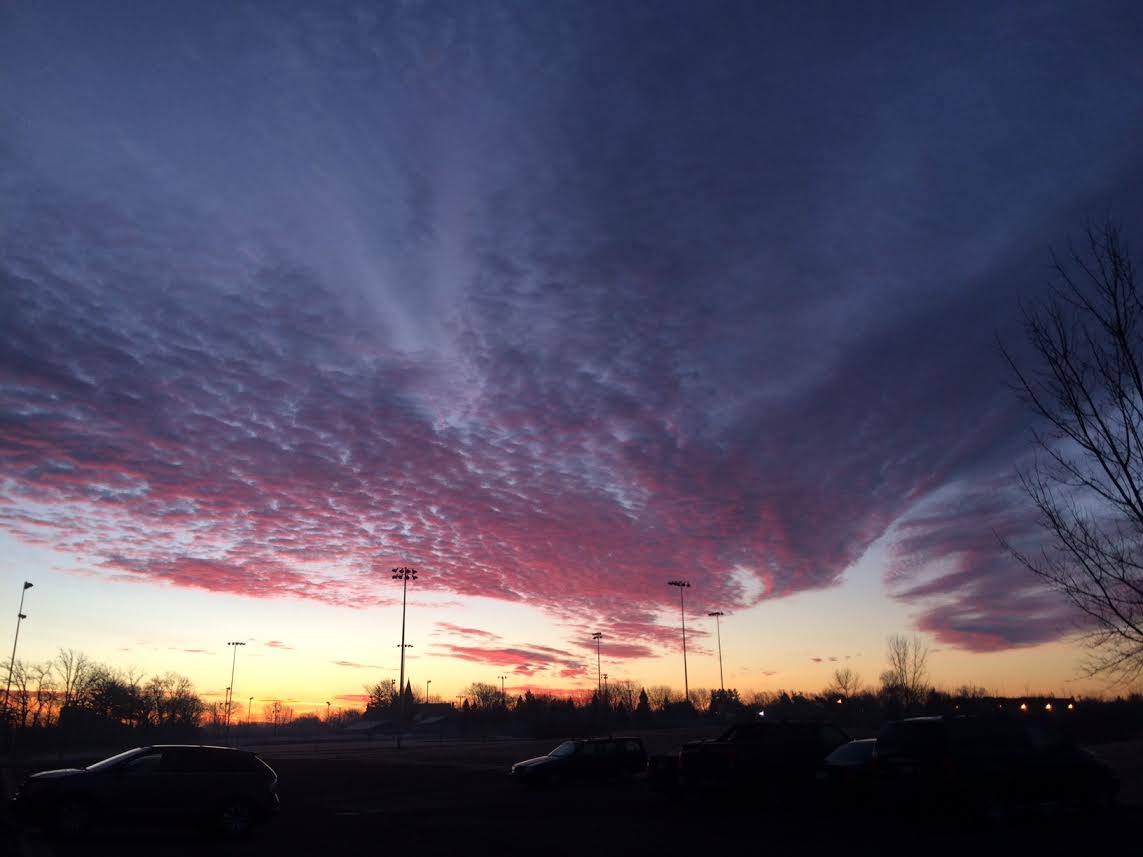
Visibile Satellite on Sunday
Here's the visible satellite loop from Sunday, which showed increasing clouds through the days. Note the high clouds streaming into the area from the southwest ahead of our next weather maker set to bring widespread showers and rumbles of thunder to the region on Monday.

Halo in Sunday's Skies
Have you ever heard the phrase "Ring around the moon or sun, then rain or snow will surely come"? There's some validity there. High clouds typically preceed weather events, which are made of ice crystals. These ice crystals reflect sunlight into a ring, which is known as a halo. Interestingly, this halo captured on Sunday afternoon is in advance of showers and storms that are expected on Monday.
Weather Outlook for Through Early Next Week
Here's the weather outlook from AM Monday to AM Tuesday. Note that widely scattered showers and even a few rumbles of thunder roll through the region on Monday, which could help to produce heavy pockets of rain. It's a fairly fast mover, so dry weather, sunshine and mild temperatures return by Tuesday. Interestingly, the 30 year average for the Twin Cities suggests that February averages less than 1 day of thunderstorms (0.1 days) during the month.

Thunder Threat Monday
Here's the thunderstorm outlook from NOAA's SPC, which suggests that general thunderstorms may be possible on Monday as the next storm system rolls through the Upper Midwest.
Here's the discussion from NOAA's SPC:
"A plume of seasonably rich low-level moisture (dewpoints in the mid 50s) over IA/MO will advect northward into MN during the day. Showers and isolated thunderstorms will likely develop during the morning to midday hours within a warm air advection regime. The antecedent clouds will delay stronger surface heating ahead of the front. Only very weak buoyancy is expected, and forecast soundings show a few hundred J/kg MUCAPE. Although a strong storm cannot be ruled out, organized severe weather is not anticipated."
"A plume of seasonably rich low-level moisture (dewpoints in the mid 50s) over IA/MO will advect northward into MN during the day. Showers and isolated thunderstorms will likely develop during the morning to midday hours within a warm air advection regime. The antecedent clouds will delay stronger surface heating ahead of the front. Only very weak buoyancy is expected, and forecast soundings show a few hundred J/kg MUCAPE. Although a strong storm cannot be ruled out, organized severe weather is not anticipated."
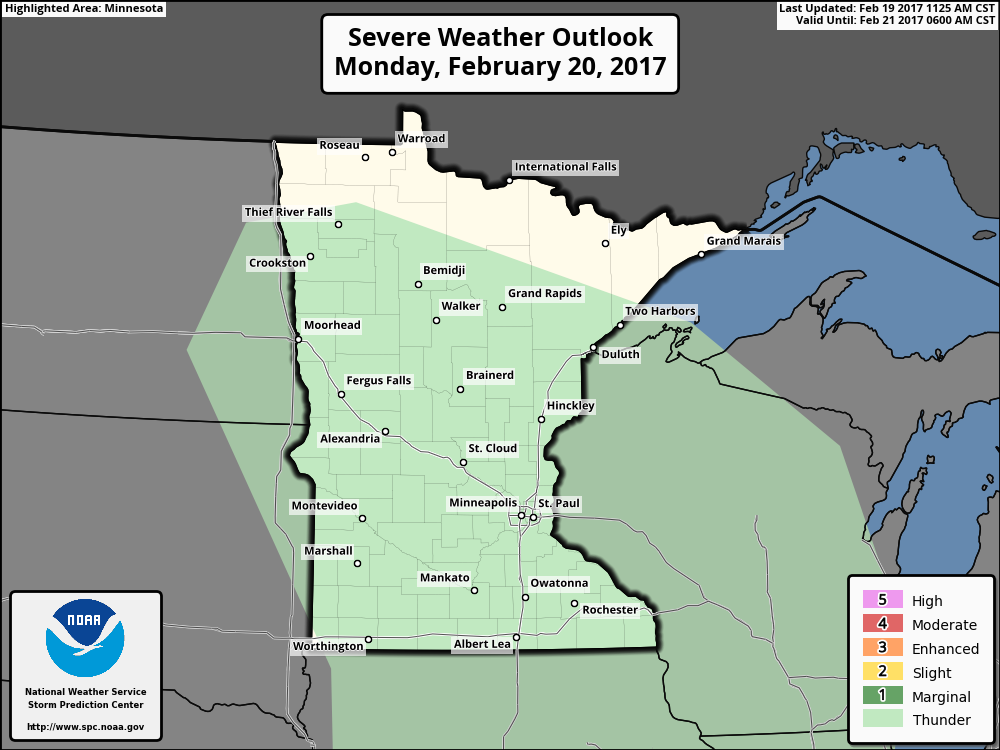
Precipitation Potential Thru Tuesday
Our next storm system will move through the Upper Midwest on Monday and will have the potential of dropping 0.25" to 0.50" liquid from mainly the Mississippi River Valley and places east. Some of the heaviest rains will be aided by thunderstorm activity.

Late Week Wintry Mix and Snow Chance?
Talk about weather whiplash, take a look at the storm system that long range weather models are trying to develop later this week. It is still WAY too early to talk about what exactly is going to happen here, but it's interesting that we could go from several days of record warmth in February to snowfall in just a few short days. Stay tuned.

____________________________________________________________________________
Record Highs on Sunday
Here were all the high temperatures that neared or broke records on Sunday! Note how widespread and how far north these record highs were across the eastern two-thirds of the nation.
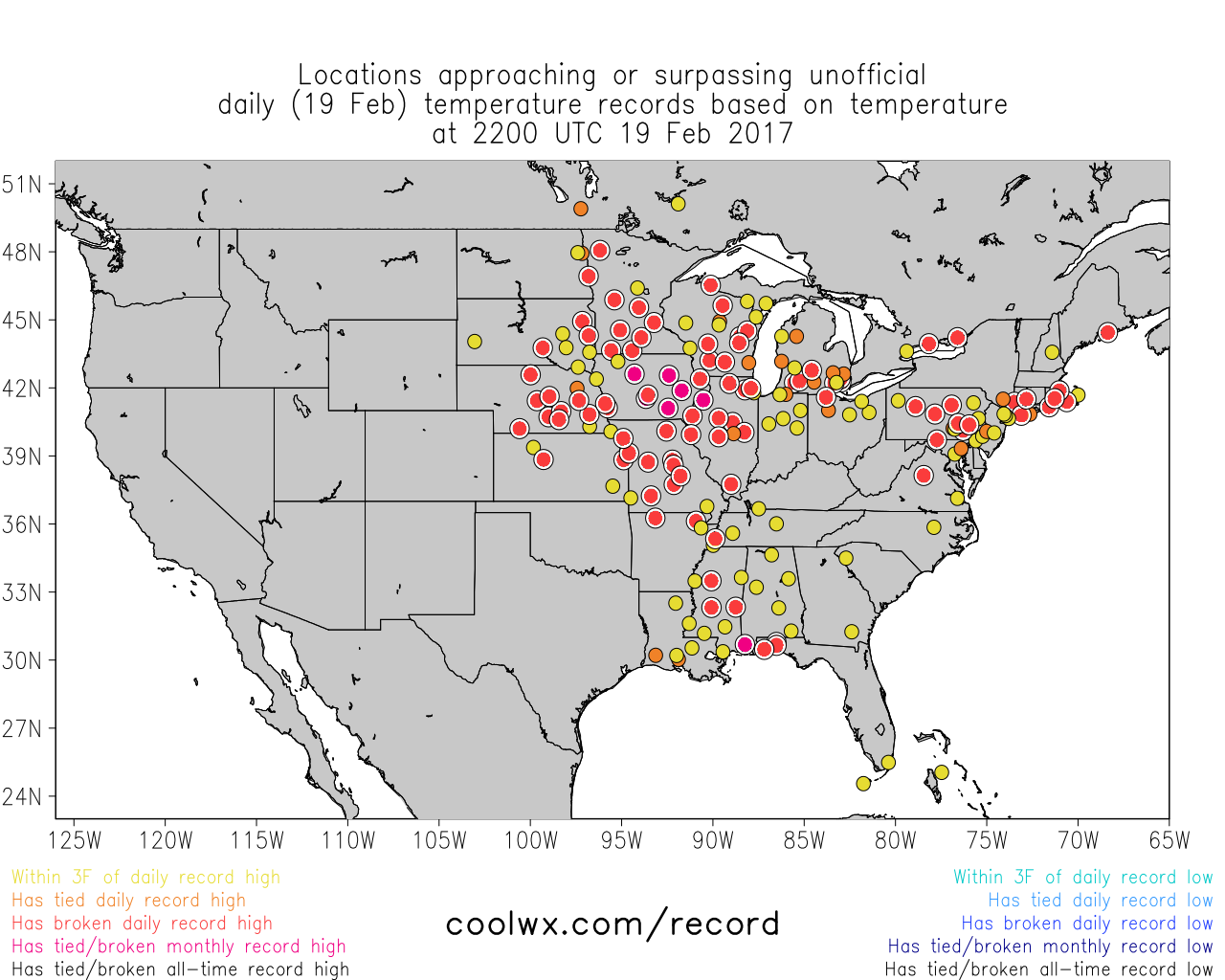
Ice Thinning Rapidly
Thanks to @DKayserWX for the picture below from Lake George in St. Cloud. Thanks to abnormally warm conditions over the past serveral days, ice conditions have been deteriorating rapidly. Several cars have been reported going through the ice on area lakes. Be extremely cautious if you venture out.
 _______________________________________________________________________________
_______________________________________________________________________________
Officials Warn of Thinning Ice Around Area Lakes
I feel cheated. I love winters in Minnesota and everything that comes along with it. Call me crazy, but I like the snows, I like the extreme cold temps and I love the winter sports. Unfortunately, this winter has been stunted. The coldest 3 months (on average) for the northern hemisphere, which is also known as Meteorological winter has been running well above average in the temperature department. Month by month here it is for the Twin Cities:
December: +1.2F above average
January: +5.3F above average
February (thru the 17th): +7.7F above average
January: +5.3F above average
February (thru the 17th): +7.7F above average
Because of that, official are warning of thin ice on area lakes. There have been several cars that have already gone through lakes, so angler should stay aware of their situation before heading out.

How Rare are 50F+ in February in the Twin Cities?
Take a look at the red lines below, this tells us how many times the Twin Cities has seen 50F or warmer since the late 1800s. Note that we've only had a maximum of 6 days and has happened only 3 times, in the 1930s and again in 1981. Note that the next 6 days are forecast to be at or greater than 50F!
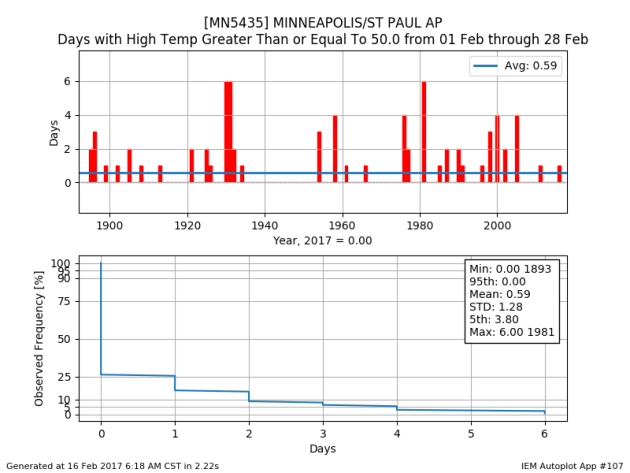
Here's the temperature outlook through February 28th, which shows well above average temperatures continuing through the middle part of next week. Note that Friday's record high temperature of 63F was the first time we've 50F and 60F in the Twin Cities since November 28th (55F) and November 16th (61F). This week will continue to feel very much like April with highs in the 50s to near 60 degrees! Unreal! Note the cool down late week as a potential snow event blows through the region.
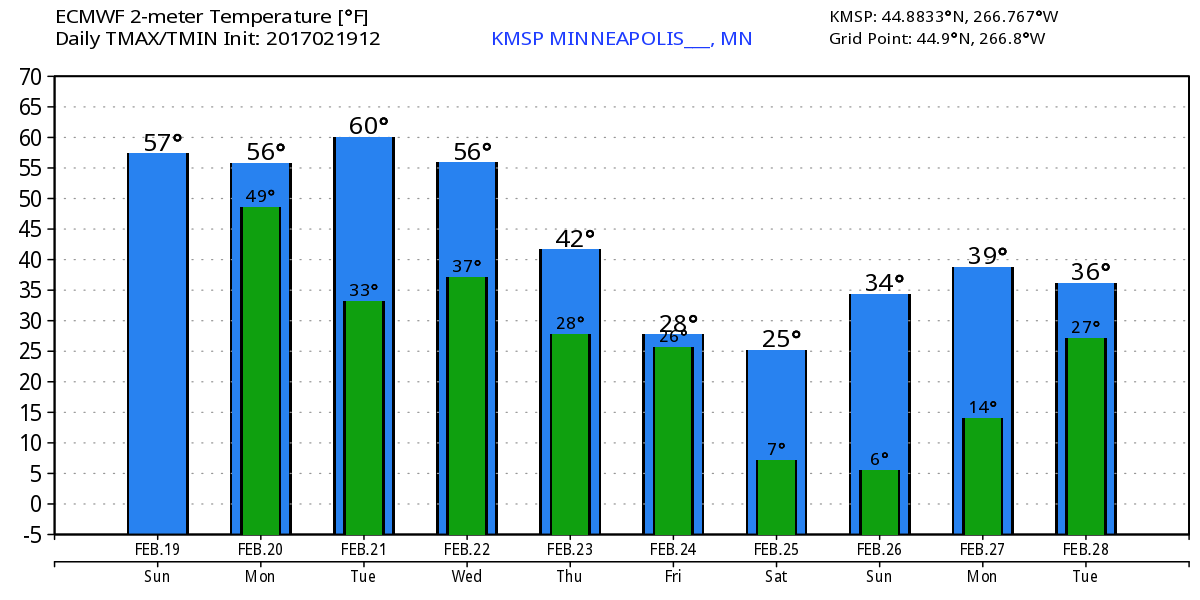
Record Warmth Continues...
Thanks to the National Weather Service for the numbers below, which tell us how high the record highs are from 2/16 to 2/22 in Minneapolis, St. Cloud and in Eau Claire. Note that several of these records have a chance at being beaten in the days to come. If you're a fan of this warmer weather during meteorological winter, enjoy!
Here are some number from the National Weather Service:
What is the record for consecutive days with highs of 50 degrees or warmer in February?
Twin Cities: 6 days (1930 and 1981)
St. Cloud: 5 days (1981)
Eau Claire: 7 days (1930)
How often does the temperature reach 60 degrees or warmer in February?
Twin Cities:
There have only been 4 days on record (back to 1873) when the temperature has reached 60 degrees or warmer in February (64 on 2/26/1896, 63 on 2/15/1921, 60 on 2/16/1981, 61 on 2/29/2000).
The earliest 60 degree reading on record is February 15th (1921).
St. Cloud:
There have been no days on record with a temperature of 60 degrees or warmer in February since temperature records began in St. Cloud in 1893.
The earliest 60 degree reading on record is March 3rd (1905).
Eau Claire:
There have only been 5 days on record (back to 1893) when the temperature has reached 60 degrees or warmer in February (60 on 2/19/1930, 60 on 2/21/1930, 61 on 2/24/1931, 63 on 2/29/2000, 61 on 2/27/2016).
The earliest 60 degree reading on record is February 19th (1930).
What is the record for the number of days in a row with temperatures above freezing in February?
The normal high temperature is 30 degrees and the normal low temperature is 14 degrees on February 17th in the Twin Cities.
Location Record for number of consecutive days with temperatures above 32 degrees in February
Minneapolis/St.Paul 6 days (February 15-20, 1998)
St. Cloud 5 days (February 15-19, 1998)
Eau Claire 4 days (February 15-18, 1981)
Twin Cities: 6 days (1930 and 1981)
St. Cloud: 5 days (1981)
Eau Claire: 7 days (1930)
How often does the temperature reach 60 degrees or warmer in February?
Twin Cities:
There have only been 4 days on record (back to 1873) when the temperature has reached 60 degrees or warmer in February (64 on 2/26/1896, 63 on 2/15/1921, 60 on 2/16/1981, 61 on 2/29/2000).
The earliest 60 degree reading on record is February 15th (1921).
St. Cloud:
There have been no days on record with a temperature of 60 degrees or warmer in February since temperature records began in St. Cloud in 1893.
The earliest 60 degree reading on record is March 3rd (1905).
Eau Claire:
There have only been 5 days on record (back to 1893) when the temperature has reached 60 degrees or warmer in February (60 on 2/19/1930, 60 on 2/21/1930, 61 on 2/24/1931, 63 on 2/29/2000, 61 on 2/27/2016).
The earliest 60 degree reading on record is February 19th (1930).
What is the record for the number of days in a row with temperatures above freezing in February?
The normal high temperature is 30 degrees and the normal low temperature is 14 degrees on February 17th in the Twin Cities.
Location Record for number of consecutive days with temperatures above 32 degrees in February
Minneapolis/St.Paul 6 days (February 15-20, 1998)
St. Cloud 5 days (February 15-19, 1998)
Eau Claire 4 days (February 15-18, 1981)
______________________________________________________________________________
Widespread Record February Warmth Through Early Next Week
As temperatures warm later this week, record warmth could follow. The images below show where record warmth is forecast (circles) for , Monday, Tuesday and Wednesday. Note that on Monday, record warmth could stretch as far north as International Falls, MN and could continue in Minneapolis through Wednesday!

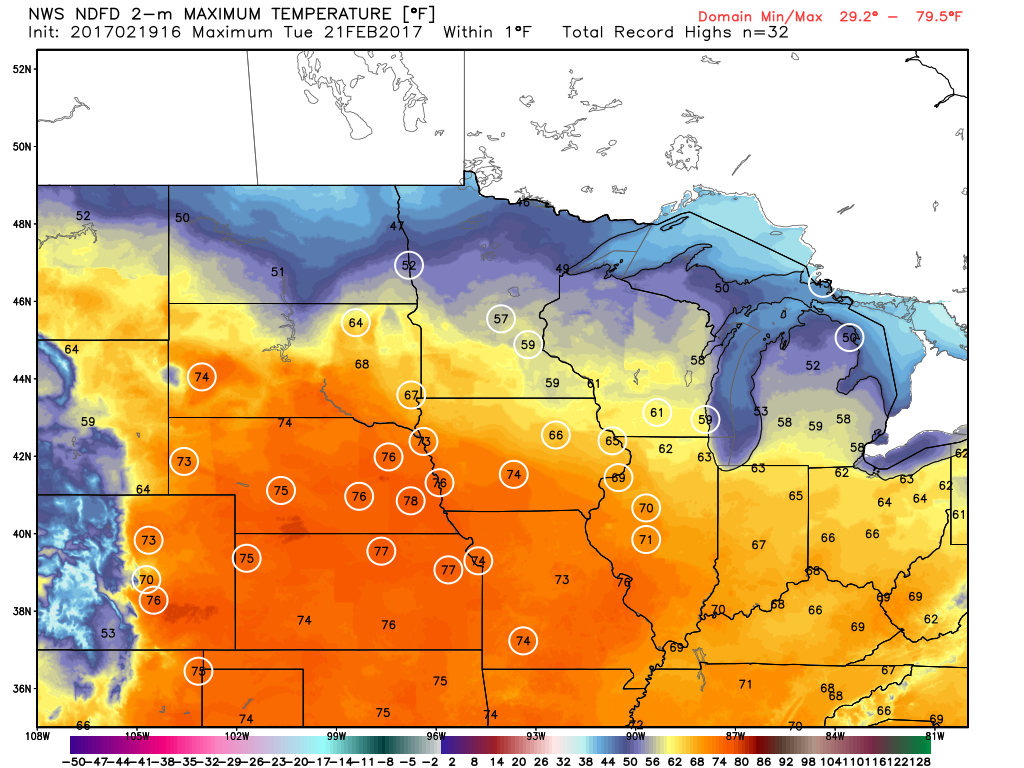
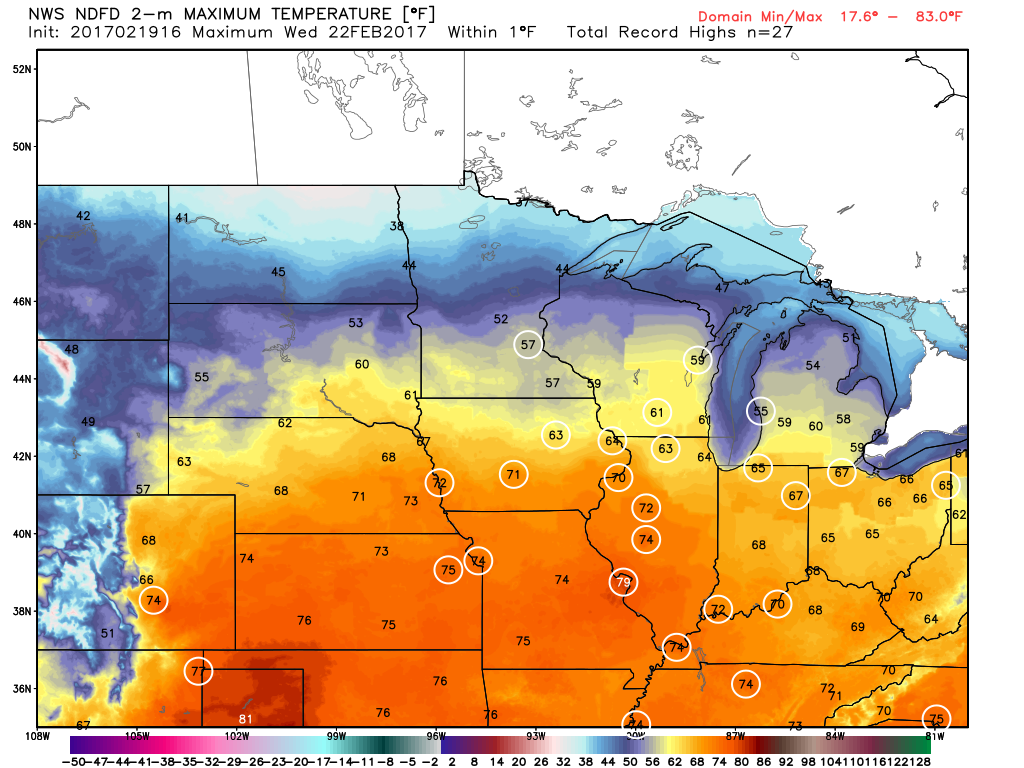
______________________________________________________________________________
As temperatures warm later this week, record warmth could follow. The images below show where record warmth is forecast (circles) for , Monday, Tuesday and Wednesday. Note that on Monday, record warmth could stretch as far north as International Falls, MN and could continue in Minneapolis through Wednesday!



______________________________________________________________________________
Rare February rumbles Monday. More record warmth
By Todd Nelson, filling in for Douglas.
By Todd Nelson, filling in for Douglas.
WOW! What a weekend. I kept pinching myself, thinking maybe I'd wake up from an early spring dream.
We've been dealing with record to near record highs across the region since Friday and it looks like it'll continue right through Wednesday. The last time we had a warm stretch like this in February was back in 1981 and so far, we've had no problem topping those numbers. Impressively, we'll still be able to sneak up close to 60 degrees Monday in the Twin Cities even with widely scattered showers and rare February thunderstorms! Note that the 30 year average suggests that we only see 0.1 thunderstorm days in February.
The sun pops back out again Tuesday with April-like mercury readings settling in by the afternoon. Wednesday is our last very warm day before a fairly potent Pacific storm blows through. Long range models are still hinting at heavy snow accumulations across parts of the Upper Midwest, but the big question is where. Still too early to tell, but stay tuned. Shovels may still be required in this odd winter.
___________________________________________________________________________
___________________________________________________________________________
Extended Forecast:
SUNDAY NIGHT: Mostly cloudy and very mild. Winds: SE 10. Low: 47.
MONDAY: Record warmth again. Breezy with scattered showers & rumbles. Winds: SSW 10-15. High: 60.
MONDAY NIGHT: Showers and rumbles end early. Clearing trend late. Winds: W 5-10. Low: 39.
TUESDAY: Sun returns. Still feels like April. Another record high. Winds: SW 5-15. High: 60.
WEDNESDAY: Breezy. Record warmth. More PM Clouds. Winds: WNW 10-15. Wake-up: 41. High: 57.
THURSDAY: Windy. Snow develops late. Winds: NE 10-20. Wake-up: 35. High: 40.
FRIDAY: Windy. Increasing snow chance. Winds: NNW 15-25. Wake-up: 27. High: 33.
SATURDAY: Feels like February again. Lingering flakes. Winds: NW 5-10. Wake-up: 18. High: 30.
SUNDAY: Partly sunny. Lingering light snow. Winds: E 5-10. Wake-up: 18. High: 21.
_______________________________________________________________________________
_______________________________________________________________________________
This Day in Weather History
February 20th
February 20th
1981: Due to the long spell of warm weather in the 60s, a farmer near Le Center is plowing some alfalfa ground.
_______________________________________________________________________________
_______________________________________________________________________________
Average High/Low for Minneapolis
February 20th
February 20th
Average High: 31F (Record: 57F set in 1981)
Average: Low: 15F (Record: -20F set in 1889)
Average: Low: 15F (Record: -20F set in 1889)
*Record Snowfall: 11.8" set in 2011
_______________________________________________________________________________
_______________________________________________________________________________
Sunrise Sunset Times For Minneapolis
February 20th
February 20th
Sunrise: 7:05am
Sunset: 5:49pm
Sunset: 5:49pm
*Daylight Gained Since Yesterday: ~3 minutes
*Daylight Gained Since Winter Solstice (December 21st): ~1 hour & 57 minutes
________________________________________________________________________________
*Daylight Gained Since Winter Solstice (December 21st): ~1 hour & 57 minutes
________________________________________________________________________________
Moon Phase for February 19th at Midnight
1.5 Days After Last Quarter
1.5 Days After Last Quarter
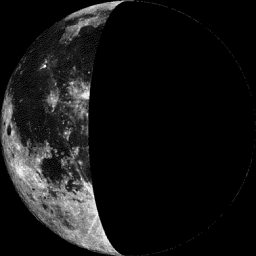
________________________________________________________________________________
Weather Outlook For Monday
High temperatuers on Monday will once again be very warm across the region with 50s and 60s across the state. Impressively, we'll be able to reach these highs even with widely scattered showers and thundershowers across the region.
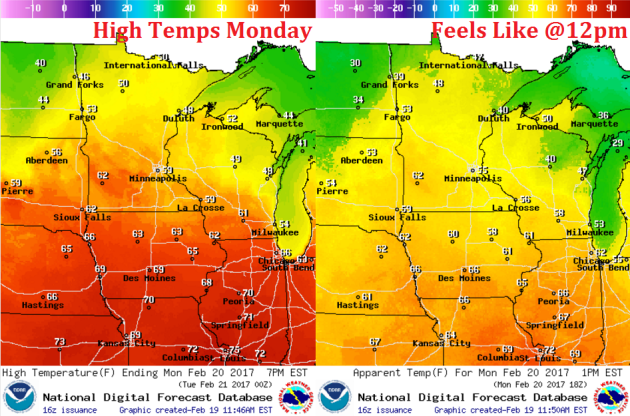
Weather Outlook For Monday
Winds will be a bit breezy on Monday as the next storm system moves through the region. South to Southeast winds ahead of the front at 10 to 15mph, while winds behind the front switch to the west and could be a little gustier across the Dakotas.
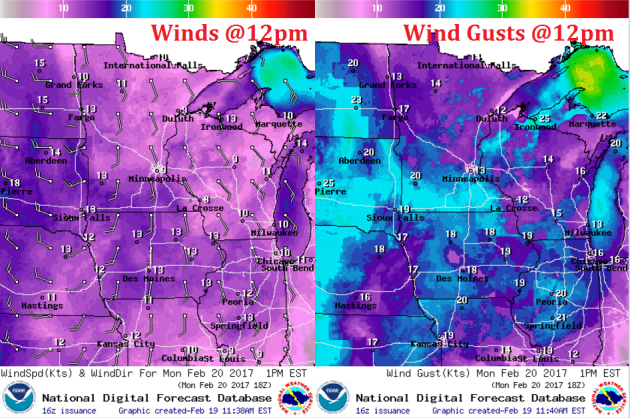

Saturday's Sun Pillar Sunset
It happened fast, but did you see Saturday's sunset? The line stretching up from the sun is called a sun pillar and forms when sunlight reflects off of ice crystals from high-level clouds.
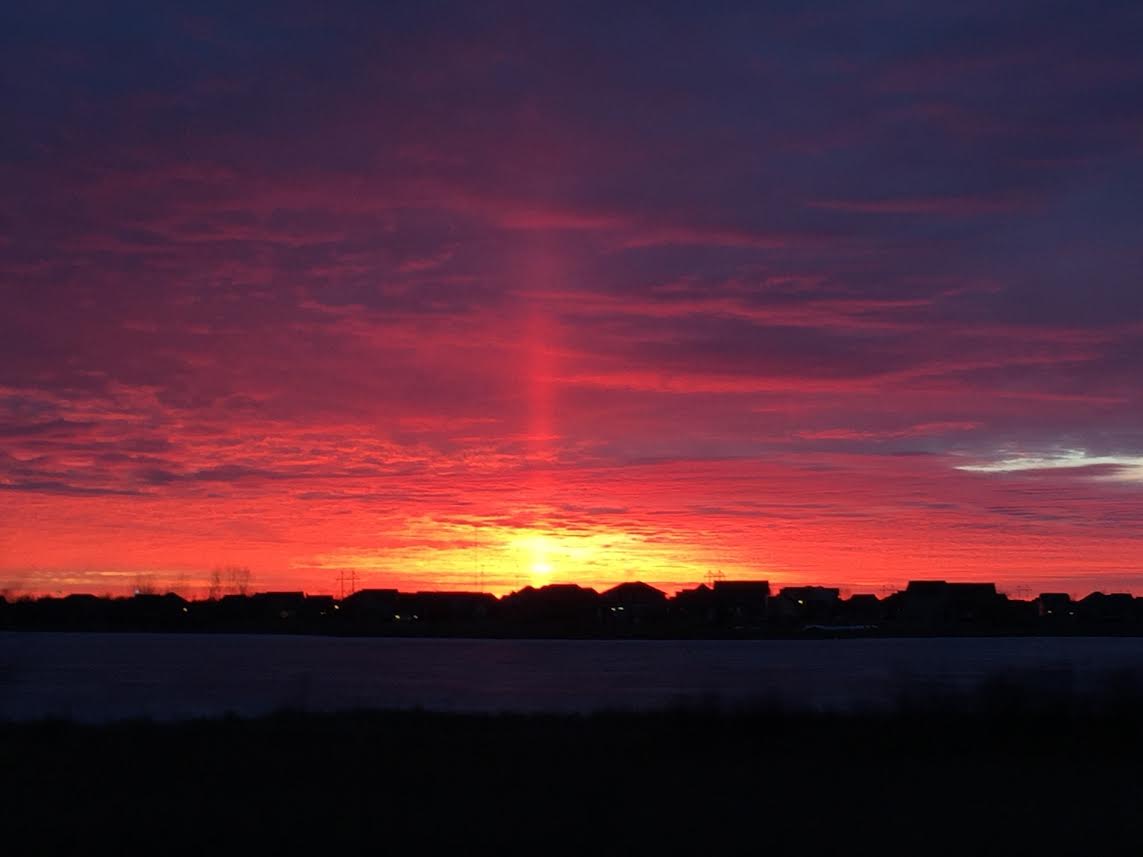
8 to 14 Day Temperature Outlook
According to NOAA's CPC, the 8 to 14 day temperature outlook suggests warmer than average temperatures continuing across much of the Upper Midwest from February 28th - March 4th. After several days of MUCH warmer than average temperatures, readings look to finally cool down by the end of the month.
_________________________________________________________________________________
Temperature Outlook
National Temp Outlook
Take a look at the temperature anomaly through Saturday, February 25th. Note that the eastern half of the country looks to stay warmer than average through early next week, but colder than average temps begin moving into the western part of the country next week.Eventually this colder weather will move into the central part of the country by the last weekend of the month.
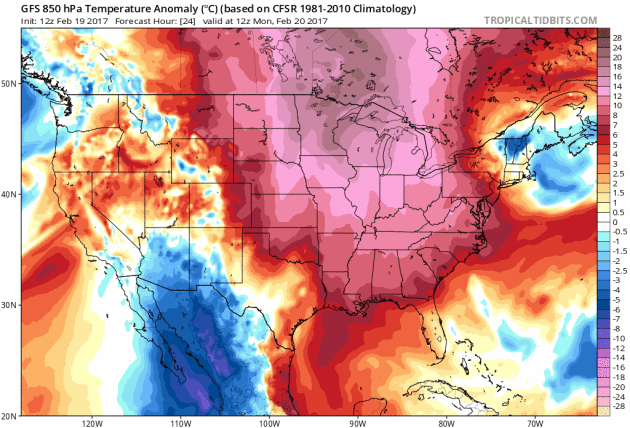 ________________________________________________________________________________
________________________________________________________________________________

National Weather Outlook
Here's the national weather outlook through early next week, which continues to shows heavy precipitation continuing in the Western US, while a wave of energy moves into the Central US with widely scattered showers and storms.


_____________________________________________________________________
Waves of Pacific Moisture in the Western U.S. Continue
Several rounds of heavy precipitation have blasted the West Coast and we're not quite done yet. Another surge of heavy precipitation will push through the region through the early week time frame with more flooding rains and heavy mountain snow.
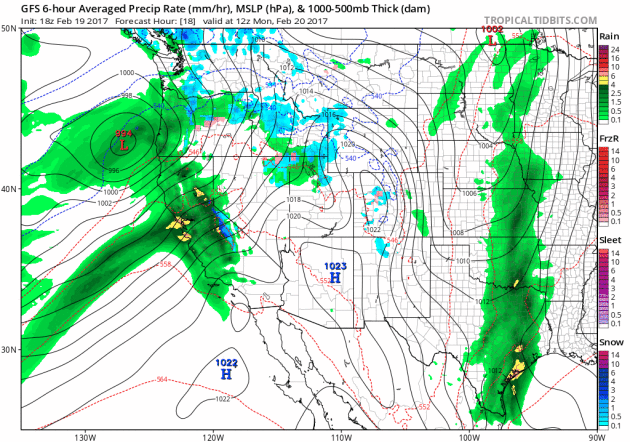
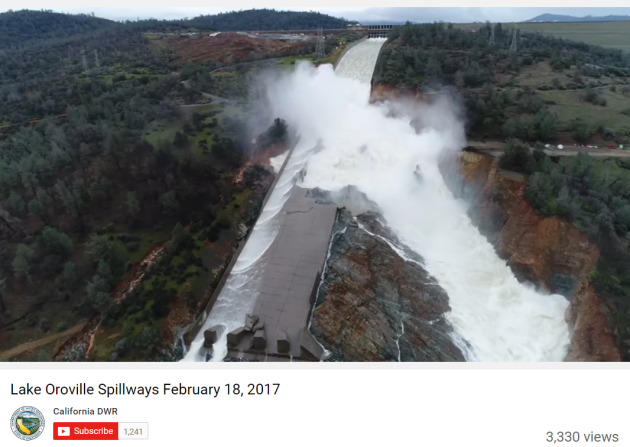
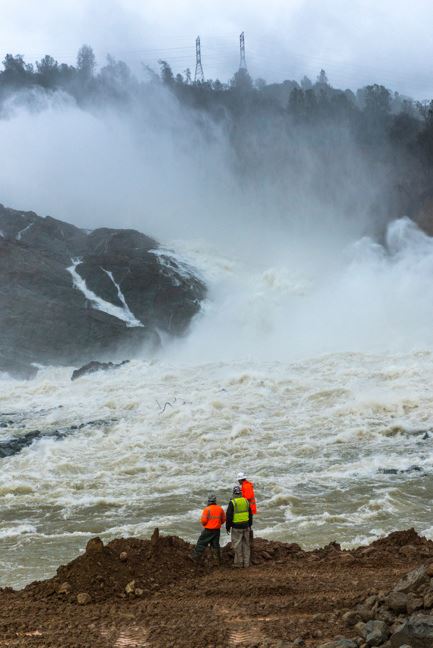
Take a look at how impressive the 30 day precipitation tallies are across the West Coast. Note the purple colors that indicate 12" of liquid! Some spots have quite a bit more than that and there's more precipitation on the way!
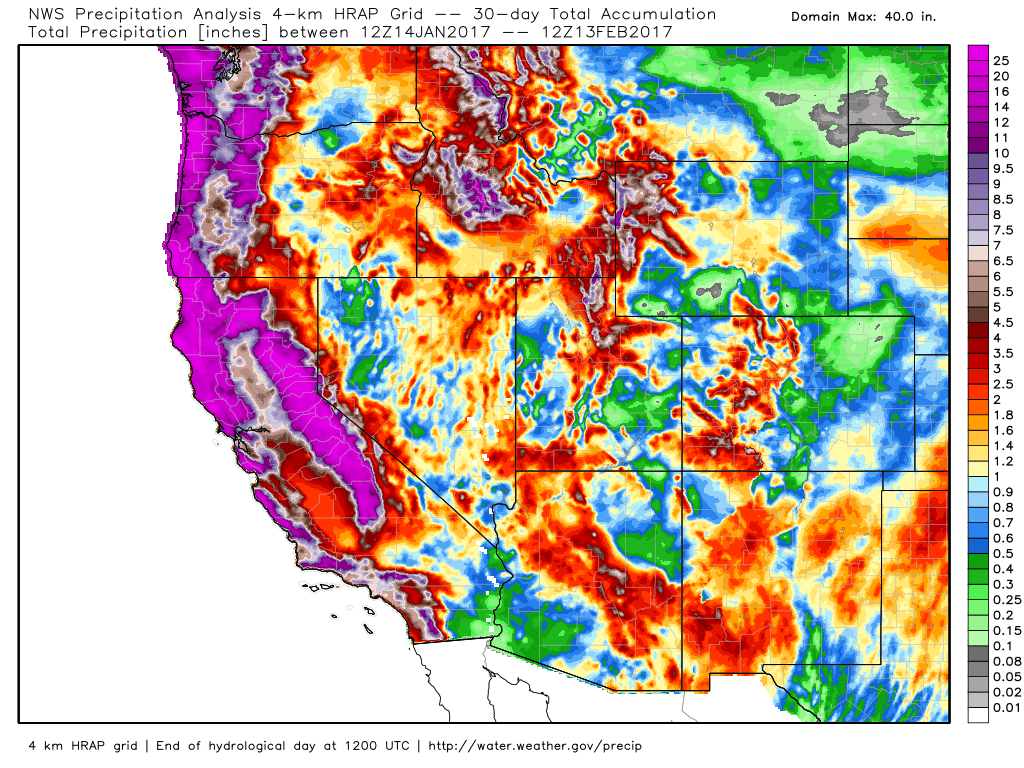
Improving California Drought
According to the U.S. Drought Monitor, the California drought continues to improve. Note that over the last 3 months, we have seen major improvement in the Exceptional, Extreme and Severe drought. With the additional moisture expected this week, we should continue to see even more improvement!
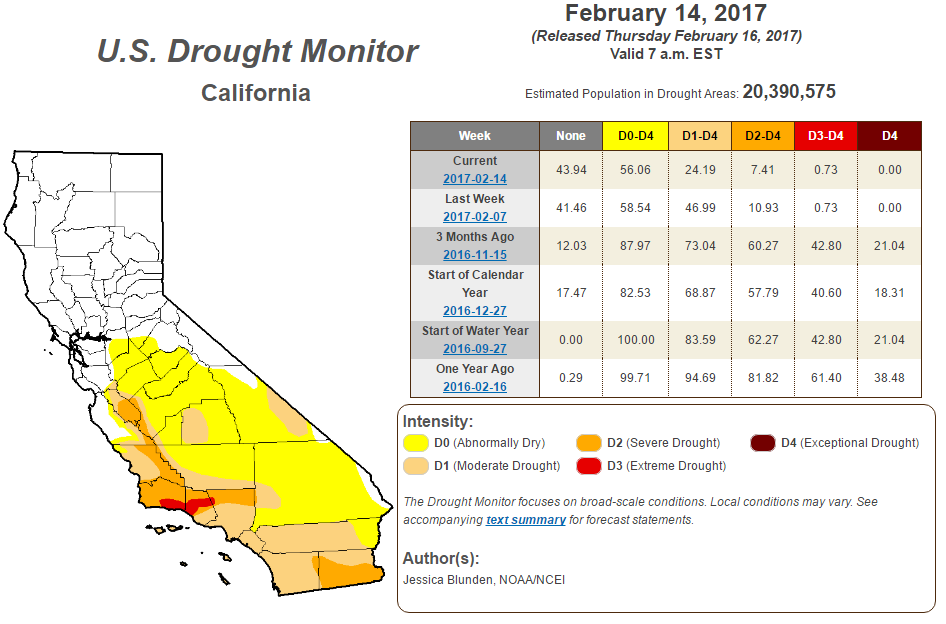

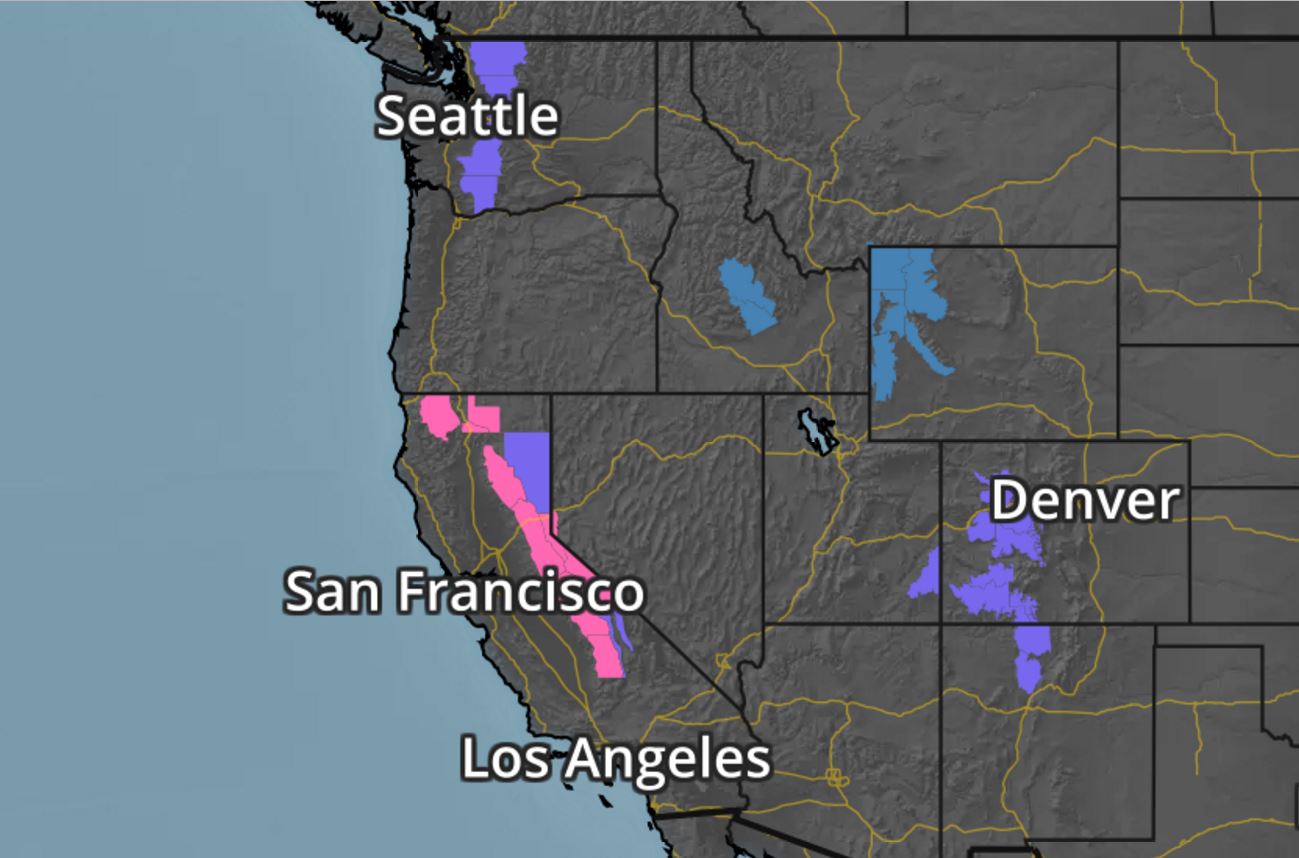
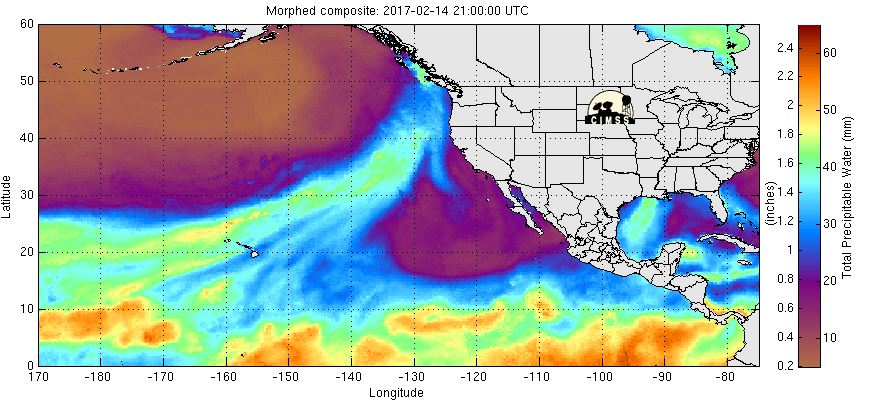 5 Day Precipitation Forecast
5 Day Precipitation Forecast

Video of Lake Oroville Spillway
This video, captured on Saturday, February 18, shows the immense progress that crews have made to armor the emergency spillway. With outflows down the flood control spillway reduced to 55,000 cfs, we get a glimpse of damage to the spillway after several days of running at 100,000 cfs. Current erosion on the lower part of the spillway has hit bedrock, while the integrity of the upper spillway remains intact. Lower spillway flows have eroded areas of the hillside south of the structure. Decreased volumes of outflow have allowed crews to clear debris that has piled up at the base of the spillway.
Lake Oriville Spillway
Workers look over the river where operators will dig access points to the river to allow heavy equipment access to remove the sediment at the base of the spillway. The California Department of Water Resources continues to repair the erosion below the Oroville Dam Emergency Spillway. More than 125 construction crews are working around the clock, and placing 1,200 tons of material on the spillway per hour using helicopters and heavy construction equipment at the Butte County site. Photo taken February 17, 2017. Brian Baer/ California Department of Water Resources

Radar Estimated Precipitation Past 30 Days

Improving California Drought
According to the U.S. Drought Monitor, the California drought continues to improve. Note that over the last 3 months, we have seen major improvement in the Exceptional, Extreme and Severe drought. With the additional moisture expected this week, we should continue to see even more improvement!

Flood Concerns Continue
Another round of very heavy rainfall is on its way to parts of central and northern California. Some spots could see another 2" to 4"+ rain through the early week time frame! With the ground already saturated and some still dealing with flooding from recent heavy rains, it wont' take much addional rainfall to create more flood concerns in the area.
Winter Weather Concerns Continue
Winter Weather Concerns continue across parts of the Western US and note that the Sierra Nevada Range is expecting another round of snow from Sunday to Tuesday. Some spots could see an additional 6" to 12"+ by the time this latest round of heavy moisture fades.
Why So Much Moisture?
Heavy precipitation has been falling across the Western U.S. due to rivers of Pacific moisture plowing into the region. Note the deep plumes of Pacific moisture that seems to be directed right toward the West Coast, these are the Atmospheric Rivers that are responsible for the extensive precipitation. Note the next big plume setting up just west of the region, this will be responsible for another heavy surge through the week ahead.

According to NOAA's WPC, the 5 day precipitation forecast suggests widespread 6" to 9"+ precipitation amounts across parts of central and northern California through the week ahead. Meanwhile a larger storm system will impacte the Upper Midwest with heavy snowfall later this week. Heavy rain will also impact the southern US
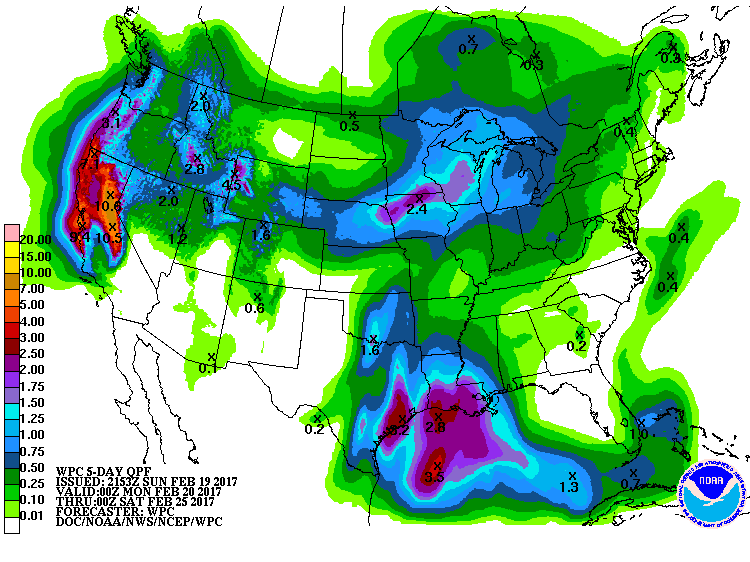
_____________________________________________________________________________

_____________________________________________________________________________
Here's the snowfall potential through the end of next week, which shows heavy mountain snow continuing across parts of the Western U.S.. Also note the snow potential across the Midwest late next week... while it is still WAY to early to tell what's happening with that particular snow chance, it's worth watching. Stay tuned!
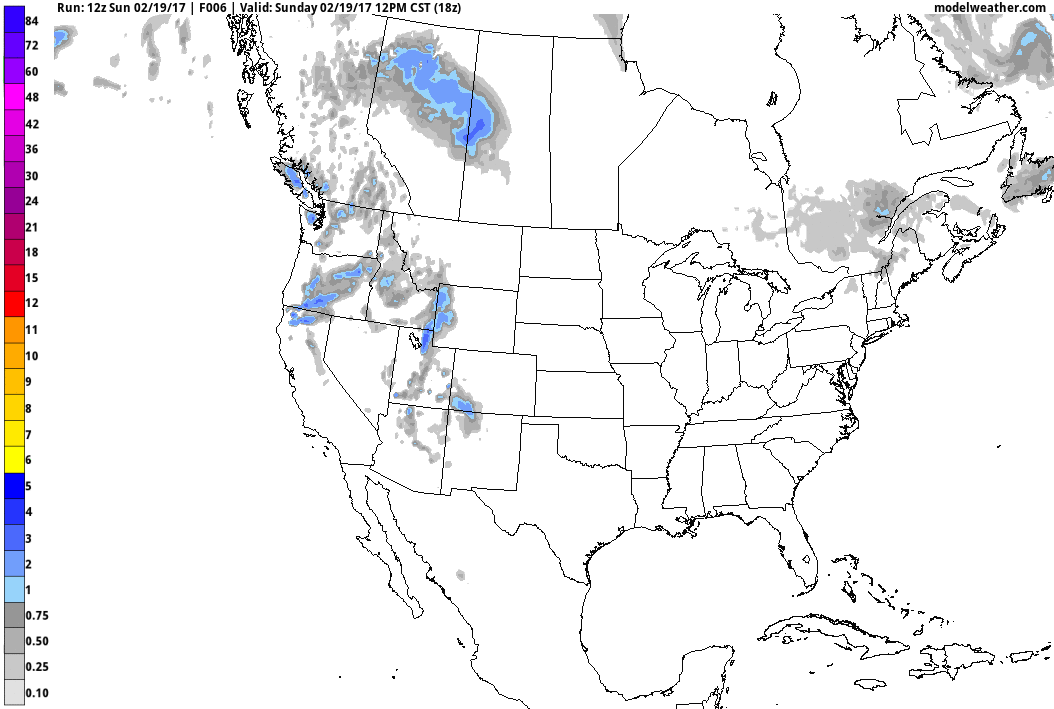
______________________________________________________________________________

_____________________________________________________________________
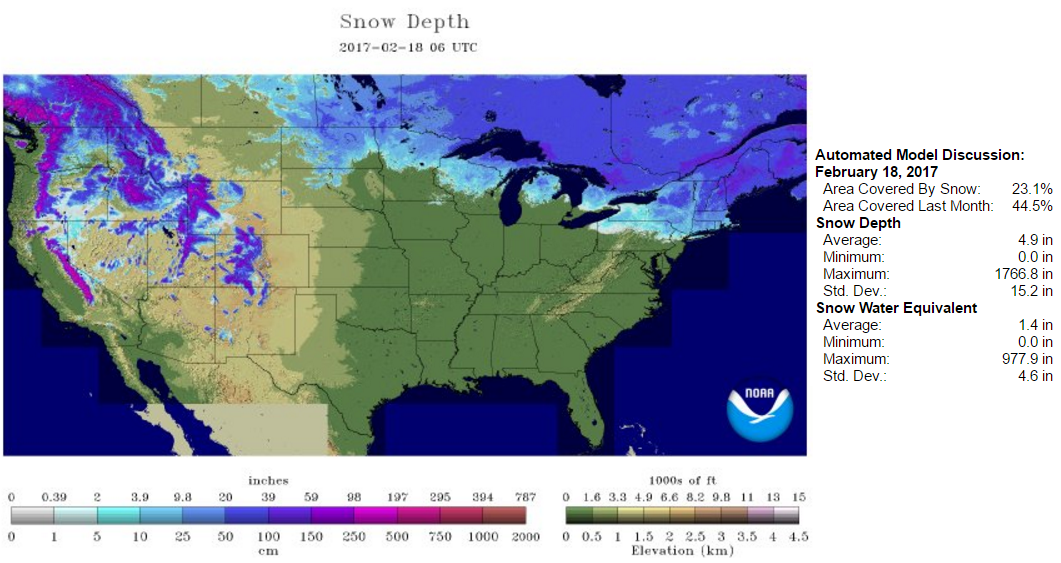


___________________________________________________________________

______________________________________________________________________________
Bofoslof Volcano Erupts in Alaska Saturday Morning...
Bogoslof volcano erupted this morning with an ash cloud estimated by pilots to about 38,000 feet. The ash cloud was identified quickly with satellite and lightning data by meteorologists at the Alaska Aviation Weather Unit, Center Weather Service Unit and Volcanic Ash Advisory Center along with volcanologists at the Alaska Volcano Observatory. Early detection of eruptions occurring in remote locations like Bogoslof volcano gives advance warning to aviators to steer clear of destructive ash clouds. Follow our partner Alaska Volcano Observatory for more on Bogoslof's ongoing period of unrest in the Aleutians.
See more from the National Weather Service Alaska HERE:
See more from the National Weather Service Alaska HERE:

_____________________________________________________________________
National Snow Coverage
According to NOAA's NOHRSC, 23.1% of the nation was covered by snow on February 18th. Note at this time last year, 32.3% of the nation was covered by snow and 44.7% of the nation was covered by snow 2 years ago.

Latest Seasonal Snowfall Tallies Across the Country
According to NOAA's NOHRSC, here are the latest seasonal snowfall tallies (in map form) across the Lower 48. Note that there are heavy pockets across in Intermountain West and across the Great Lakes Region, but the heaviest is across the Northern New England States. Some spots there have seen nearly 96" of snow or more since September 30, 2016.

___________________________________________________________________
"Marine Ecosystems Are Preparing for Climate Change"
Coral reefs, kelp forests and other marine ecosystems may be tougher than we give them credit for, a new study suggests. While countless scientific reports have documented the ravages of climate change on oceanic life, a survey of the researchers who wrote them provides a silver lining: An overwhelming majority noticed examples of sea life withstanding climate change. “There are instances where sensitive ecosystems have shown remarkable resilience after climatic events. You can think of them as 'bright spots': They demonstrate that there are conditions under which ecosystems can persist even with major climate disturbances,” said Jennifer O'Leary, a marine conservation biologist with California Polytechnic State University and leader of the study.
(Credit: David Abercrombie Flickr (CC BY-SA 2.0))

___________________________________________________________________
"A NASA Astronaut Just Pulled Off an Awesome Prank in Space"
NASA astronaut Peggy Whitson just pulled off a prank that's literally out of this world. Whitson, a veteran space traveler, is one of six people living and working on the International Space Station right now. And while astronauts are usually pretty busy in space, Whitson found time Monday (Feb. 13) to surprise her Russian crewmates with a gag you could only pull off in space. As you can see here, Whitson packed herself inside a cargo bag and enlisted two partners-in-prank (NASA's Shane Kimbrough and France's Thomas Pesquet) to surprise their Russian crewmates. [Fun in Zero G: Awesome Weightless Photos] "They were quite surprised when I popped out!" Whitson wrote in a Twitter post.
(NASA astronaut Peggy Whitson pops out of a cargo bag during a prank on the International Space Station on Feb. 13, 2017. Credit: Peggy Whitson/Twitter/NASA)
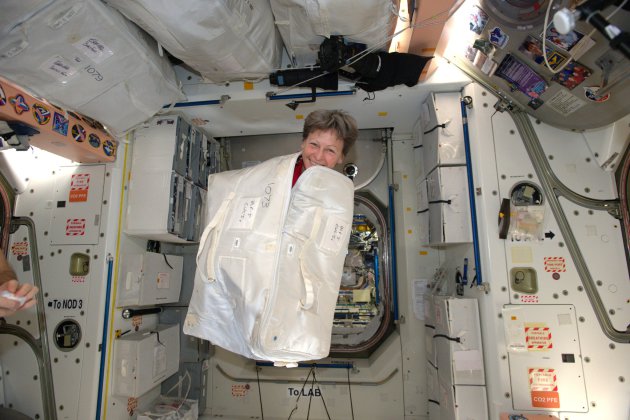
"The Northern Lights is distracting drivers, Icelandic police warn"
"We are all familiar with the risks of driving under the influence of alcohol, but what about driving under the influence of the Aurora Borealis? Well, that’s becoming an increasing problem in Iceland, according to local police, who say foreign motorists are driving dangerously because they are being distracted by the Northern Lights. According to the local news site, Víkurfréttir, police stopped two motorists for driving dangerously last week; in both incidents the officers suspected the drivers were drunk, but soon realised they had a more innocent explanation for their behaviour: they had been distracted by the light show above them."
(Motorists have reportedly been "driving under the influence of the Aurora Borealis"CREDIT: AP/FOTOLIA)
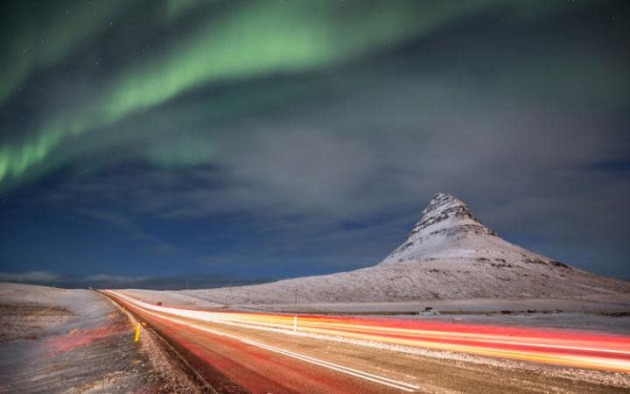
________________________________________________________________________________
"Scientists have just detected a major change to the Earth’s oceans linked to a warming climate"
"A large research synthesis, published in one of the world’s most influential scientific journals, has detected a decline in the amount of dissolved oxygen in oceans around the world — a long-predicted result of climate change that could have severe consequences for marine organisms if it continues. The paper, published Wednesday in the journal Nature by oceanographer Sunke Schmidtko and two colleagues from the GEOMAR Helmholtz Centre for Ocean Research in Kiel, Germany, found a decline of more than 2 percent in ocean oxygen content worldwide between 1960 and 2010. The loss, however, showed up in some ocean basins more than others. The largest overall volume of oxygen was lost in the largest ocean — the Pacific — but as a percentage, the decline was sharpest in the Arctic Ocean, a region facing Earth’s most stark climate change."
(Big waves generated by the Nazare canyon just off the coast of Nazare, central Portugal, in the Eastern Atlantic Ocean. (Francisco Leong/Agence France-Presse via Getty Images))
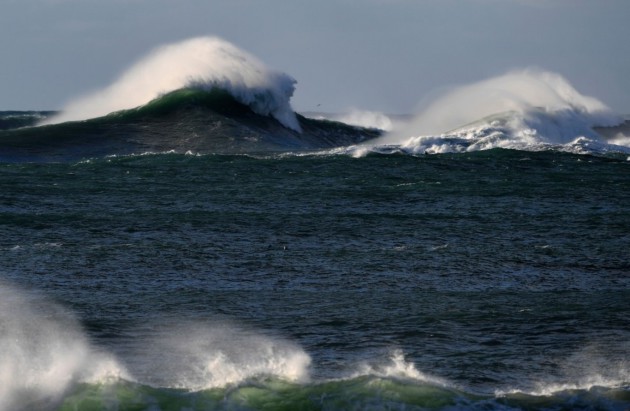
Thanks for checking in and don't forget to follow me on Twitter @TNelsonWX

No comments:
Post a Comment